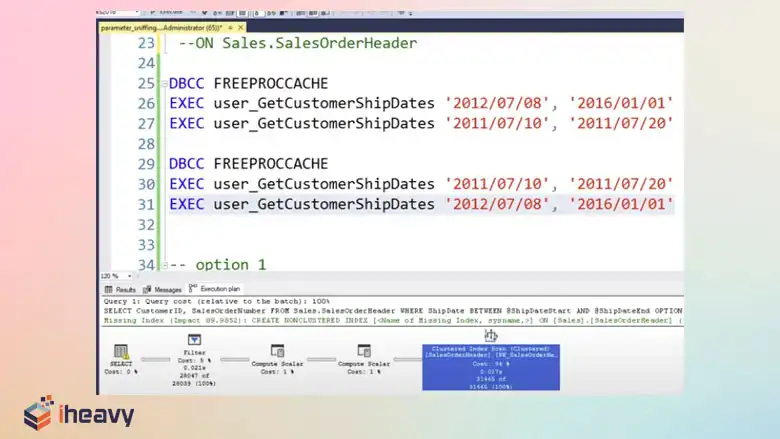How to Identify Parameter Sniffing in SQL Server
Parameter sniffing is a performance optimization technique in SQL Server where the query optimizer uses the values of parameters passed to a stored procedure during compilation to generate an execution plan.
While this is generally beneficial, it can sometimes lead to performance issues if the initial parameter values are not representative of the typical workload. In this article, we shall help you discover ways to identify the parameter sniffing phenomenon in SQL server.

What Causes Parameter Sniffing?
When a stored procedure is executed, SQL Server uses the parameter values provided to create an execution plan. This plan is then cached for future use. The problem arises when the initial parameter values are atypical compared to subsequent ones.
In such cases, the cached plan might not be optimal for the majority of executions, leading to performance degradation. Parameter sniffing can manifest in several ways:
Inconsistent query performance: You might observe significant fluctuations in query execution times, with some runs being exceptionally fast while others are painfully slow.
Resource hogging: Queries might consume excessive CPU, memory, or I/O resources, indicating inefficient execution plans.
Suboptimal execution plans: Analyzing the query execution plans can reveal choices that don’t align with optimal performance.
Post-restore or refresh performance drops: Changes in data distribution after database restore or refresh can adversely impact plan quality.
How to Detect Parameter Sniffing in SQL Server?
Several tools and techniques can help you pinpoint parameter sniffing:
Query Store
This built-in feature provides valuable insights into query performance. The “Queries with High Variation” report can be particularly helpful in identifying potential parameter sniffing issues. Additionally, analyzing wait statistics can reveal resource bottlenecks associated with suboptimal plans.
Dynamic Management Views (DMVs)
DMVs like sys.dm_exec_query_stats offer detailed information about query execution, including estimated and actual row counts. Discrepancies between these values can be a red flag for parameter sniffing. sys.dm_exec_cached_plans allows you to inspect cached plans and compare them based on parameter values.
Example Query Using sys.dm_exec_query_stats:
SELECT
qs.sql_handle,
MIN(qs.total_elapsed_time) AS min_elapsed_time,
MAX(qs.total_elapsed_time) AS max_elapsed_time
FROM
sys.dm_exec_query_stats qs
GROUP BY
qs.sql_handle
HAVING
MAX(qs.total_elapsed_time) / MIN(qs.total_elapsed_time) > 10;This query identifies queries with a significant variation in execution times, which could be a symptom of parameter sniffing.

Execution Plan Analysis
Carefully examining execution plans for different parameter values can highlight inconsistencies. Pay attention to estimated versus actual row counts, as significant differences often point to parameter sniffing.
Workload Analysis
Understanding the distribution of parameter values in your workload is crucial. Identifying outliers can help isolate specific parameter values that might be causing issues.
Trace Flags
Experiment with trace flags like 4136 (disable parameter sniffing) to isolate the impact of parameter sniffing on query performance. However, use trace flags cautiously as they can affect overall system behavior.
How to Avoid Parameter Sniffing in SQL?
Once you’ve confirmed parameter sniffing as the culprit, several strategies can help mitigate its impact:
- Optimize for Unknown: The OPTIMIZE FOR UNKNOWN hint forces SQL Server to create a plan without relying on specific parameter values.
- Local Variables: Introducing local variables can decouple parameter values from the query, potentially improving plan quality.
- Query Hints: Hints like FORCE RECOMPILE or OPTION (RECOMPILE) can be used to control plan generation.

- Index Tuning: Ensuring appropriate indexes are in place can help address performance issues related to different parameter values.
- Parameterization: Adjusting application code to provide more consistent parameter values can reduce the likelihood of parameter sniffing.
Frequently Asked Questions
Is parameter sniffing good or bad?
Parameter sniffing is a normal function of SQL Server designed to improve performance. However, the specific data within your tables and the nature of your queries can sometimes cause parameter sniffing to produce inefficient execution plans.
How does parameter sniffing hamper the query performance?
A clear sign of parameter sniffing is inconsistent performance in stored procedures. This means the procedure can run quickly at times but be very slow at others.
Conclusion
Parameter sniffing in SQL server is a complex issue, and the best solution often involves a combination of approaches. So, carefully analyze your workload and experiment with different strategies to find the optimal approach for your specific environment. With that said, implementing DMVs can be your best friend when it comes to detecting parameter sniffing beforehand.





